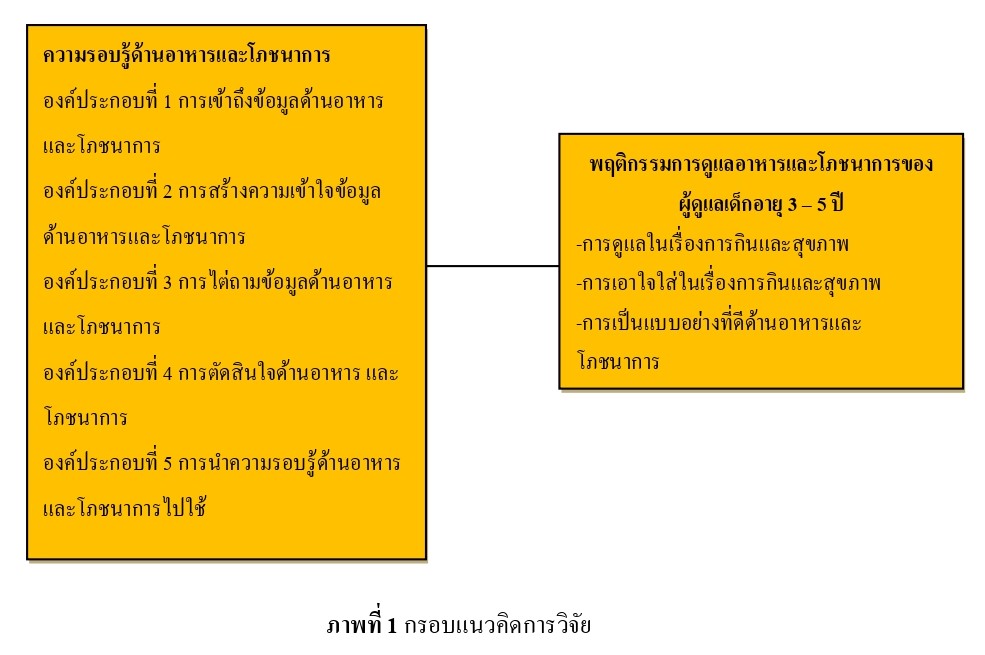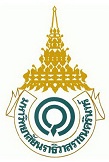Relationship Between Food and Nutrition Literacy and Caring Behavior about Food and Nutrition among Caregivers of Children Aged 3-5 Years
Keywords:
Food and nutrition literacy, Caring behavior about food and nutrition, Caregivers of childrenAbstract
This descriptive research study aimed to examine the relationship between food and nutrition literacy and caring behavior about food and nutrition among caregivers of children aged 3-5 years. Samples were 174 caregivers of children aged 3-5 years in Tha Ruea subdistrict, Mueang district, Nakhon Si Thammarat province by using simple random sampling. Instruments were a food and nutrition literacy questionnaire and a questionnaire assessing caring behavior about food and nutrition among caregivers. The content validity indices were 0.95 and 0.86, respectively. Data were analyzed by using frequency, percentage, average, standard deviation, and Pearson’s Correlation Coefficient.
The findings showed that food and nutrition literacy was at a suitable level (36.2%), caring behavior about food and nutrition was at a moderate level (52.3%). There was a strong statistically significant positive correlation between food and nutrition literacy and caring behavior about food and nutrition among caregivers of children aged 3 - 5 years at .01 (r = .516 p = .00). Regarding the component, it was discovered that accessing information about food and nutrition, developing an understanding of that information, asking for information about food and nutrition, making decisions about food and nutrition, and bringing food and nutrition literacy to apply had statistically significant relationships with caring behavior about food and nutrition at 0.1 (r = 0.379, 0.503, 0.436, 0.493, 0.439,
p = 0.00), respectively.
The caregiver is a crucial person in caring about food and nutrition for children. As a result, this research should serve as a guideline for raising food and nutrition literacy in order to encourage responsible behavior that leads to healthy nutrition for children.
References
Attharos, T., Siricharoenwong, K., & Pidjadee, C. (2021). Experiences of parents and teachers for enhancing health literacy of preschool children. Journal of The Police Nurses, 13(1), 199 - 207. https://he01.tci-thaijo.org/index.php/policenurse/article/download/244755/169325/
Chinnamart, K. (2024). Factor associated with health literacy and the relationship between health literacy, nutritional status, and early childhood development among caregivers. Research andDevelopment Health System Journal, 17(2), 140 - 153. https://he02.tci- thaijo.org/index. php/RDHSJ/article/view/266463
Chobthamasakul, S. (2019). Relationship between health literacy and obesity prevention behavior of undergraduate students in Bangkok Metropolitan Region. Journal of Interdisciplinary Research: Graduate Studies, 8(1), 116 - 123. http://dx.doi.org/10.2139/ssrn.3335182
Choeisuwan, V. (2017). Health literacy: Concept and application for nursing practice. Royal Thai Navy Medical Journal, 44(3), 183 - 197. https://he01.tci-thaijo.org/index.php/nmdjournal/ article/view/115970/178174
Chukumnird, S., Suwanraj, M., Chuakompeng, A., Warahut, J., & Nakaramontree, S. (2023). Development of Food and Nutrition Knowledge Assessment Tool for Parents of Children aged 3-5 years [Master’s thesis]. Boromarajonani College of Nursing, Songkhla, Faculty of Nursing, Praboromarajchanok Institute.
Cohen, J. (1988). Statistical power analysis for the behavioral sciences (2nd ed.). Lawrence Erlbaum Associates.
Department of Health. (2022). Annual Report 2022 Nutrition Surveillance. Author.
Faengphong, N., Jandee, P., & Panyatanakun, N. (2023). Health literacy of caregivers and teachers about preschool-aged Care in Ubon Ratchathani province. Journal of The Royal Thai Army Nurses, 24(1), 441-449. https://he01.tcithaijo.org/index.php/JRTAN/article/download/261 232/177489/1068387
Julsukon, A., Piaseu, N., Thipsuwannakool, V., & Lininger, J. (2019). Nutrition literacy and health outcomes in older adults with type 2 diabetes. Journal of Thailand Nursing and Midwifery Council, 34(4), 120 - 135. https://he02.tci-thaijo.org/index.php/TJONC/article/view/183563/ 151740
Kaeodumkoeng, K. (2018). Health literacy: Access, understanding and application. Amarin.
Kaeodumkoeng, K. (2021). Health literacy: Processes, Practices, Evaluation tools. ID All Digital Print.
Koonnawut, P. (2023). The Relationship between Health Literacy and Health Behaviors of Village Health Volunteers. STOU academic Journal of research and innovation (Humanitiesand Social Science), 3 (2), 94 - 105. https://so04.tci-thaijo.org/index.php/InnovationStou/ article/ view/267127/182452
Krisame, K. (2020). Effects of child caregivers’ self-efficacy enhancement program for promoting child complementary feeding practice on infants’ nutrition status. Academic Journal of Mahasarakham Provincial Public Health Office, 4(8), 72 - 84. https://thaidj.org/index. php/AJMP/article/view/9528
Kusol, K., Kaewpawong, P., Eaksirinimit,T., & Hongsum,T. (2023). Food Consumption Behaviors and Growth of Preschool Children in Child Development Centers, Thasala District, Nakhon Si Thammarat Province. Journal of Southern Technology, 16(1), 41 - 53. https://so04.tci-thaijo.org/index.php/journal_sct/article/view/257762
Mahmood, L., Barrantes, F.P., Moreno, L.A., Manios, Y., Gonzalez-Gil, E.M., (2021). The Influence of Parental Dietary Behaviors and Practices on Children’s Eating Habits, Nutrients, 13(4), 1 - 13. https://doi.org/10.3390/ nu13041138
Nutbeam, D. (2000). Health literacy as a public health goal: a challenge for contemporary health education and communication strategies into the 21st century. Health Promotion International, 15(3), 259 - 267. https://doi.org/10.1093/heapro/15.3.259
Office of the education council: Ministry of Education. (2019). National standard for early childhood care, development and education Thailand. Pikwhan-graphic.
Park, D., Park, Y.K., Park, C.Y., Choi, M.K., & Shin, M.J. (2020). Development of a comprehensive food literacy measurement tool Integrating the food system and sustainability. Nutrients, 12(11), 3300. https://doi.org/10.3390/nu12113300
Photihung, P. (2021). Relationship of health literacy to health promoting and disease prevention behaviors in Thailand: A systematic review. The Journal of Faculty of Nursing Burapha University, 29(3), 115 - 130. https://he02.tci-thaijo.org/index.php/Nubuu/article/view/253998
Playthuen, I, Jusawat, J., Maungkum, S., Choichai, C., Sroiruangsri, K., & Jariyatatkone, K. (2021). Parents’ role in promoting eating behavior of early childhood in Mueang District Nakhon Nayok. Journal of Early Childhood Education Management, 3(1), 1 - 13. https://so02.tci-thaijo.org/index.php/ECEM/issue/view/17163/4341
Potipiti, K. (2022). Heath literacy of major caregivers and teachers/child caregivers about early childhood care in the Health Region 5. Journal of Regional Health Promotion Centre7 Khonkaen, 15(1), 28 - 50. https://he01.tci-thaijo.org/index.php/johpc7/article/view/259412
Richter, L., Black, M., Britto, P., Daelmans, B., Desmond, C., Devercelli, A., Vargas-Barón, E. (2019). Early childhood development: An imperative for action and measurement at scale. BMJ global health, 4(Suppl 4), e001302. https://doi.org/10.1136/bmjgh-2018-001302
Sonart, B. (2019). A Health Literacy Guideline on Health Promotion Behaviors for Working Age Populations in Bangkok and Metropolitan Region [Master’s thesis]. Silpakorn University.
Sorensen, K., Pelikan, M.J., Rothlin, F., Ganahl, K., Slonska, Z., Doyle, G, Fullam, J., Kondilis, B., Agrafiotis, D., Uiters, E., Falcon, M., Mensing, M., Tchamov, K., Broucke, S., & Brand, H. (2015). Health literacy in Europe: comparative results of the European health literacy survey (HLS-EU). European Journal of Public Health, 25(6), 1053 – 1058. http://doi.org/10.1093/ eurpub/ckv043
Thai Health Promotion Foundation. (2018). Food nutrition for school-aged children. www.thaihealth.or.th.
Thongthai, T., Boonjeam, S., Puriso, P, Srimanon, N., & Deeunkong, L. (2023). Health literacy in early childhood rearing of parents in the Health Area 7. Thailand Journal of Health Promotion and Environmental Health., 46(1), 140 - 153. https://hpci.anamai.moph.go.th/ kpr/kpr2566/report66/1.
Tiengsomboon, U. (2020). The effect of self-help group program for caregivers on aggressive behavior management in school-age children with learning disabilities. Journal of Ratchasuda College for Research and Development of Persons with Disabilities, 17(1), 102 - 119. https://so03.tci-thaijo.org/index.php/RSjournal/article/view/253836/169983
Vidgen, H., & Gallegos, D. (2014). Defining food literacy and its components. Appetite, 76(1), 50 - 59. http://doi.org/10.1016/j.appet.2014.01.010
Voragoondumrong, S, Khantreejitranon, A., & Saratapan, N. (2023). Parents’ Knowledge Related to Food Consumption Behavior of Early Childhood Children at Home Economics Kindergarten School. Journal of Kasetsart Education Review, 38(2), 160 - 169. https://so04. tci-thaijo.org/index.php/eduku/article/view/263285/183254
Wongchaiudomchoke, A., & Jaruchainiwat, P. (2018). Parents’ roles in using technology and interactive media with preschoolers under the primary educational service srea in Klong-toei District, An Online Journal of Education, 13(1), 245 - 259. https://so01.tci-thaijo.org/ index. php/OJED/article/view/147635
World Health Organization. (2014, April 27). The health literacy toolkit for low- and middle-income countries.
https://iris.who.int/bitstream/handle/10665/205244/B5148.pdf;jsessionid=E479E5 D1643B5A175E23608E847C5084?sequence=1
World Health Organization. (2023, May 23). Levels and Trends in Child alnutrition: UNICEF/WHO/ The World Bank Group Joint Child Malnutrition Estimates: Key Findings of the 2021 edition. https://www.who.int/publications/i/item/9789240073791

Downloads
Published
How to Cite
Issue
Section
License
Copyright (c) 2025 Princess of Naradhiwas University Journal

This work is licensed under a Creative Commons Attribution-NonCommercial-NoDerivatives 4.0 International License.



